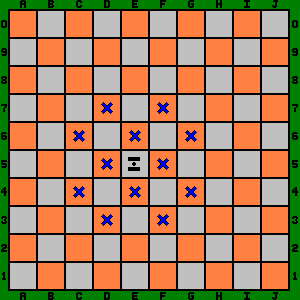

"...may move one straight and one diagonal, and may jump intervening pieces..."(Chapter II of
the TEXT)
"...2 spaces, one straight and one diagonal in any direction."(APPENDIX)
Here, again, there are two versions of movement. In the TEXT, the THOAT is given the
ability to JUMP but no such ability is denoted in the APPENDIX. Some would offer that "that
which is not specifically denied is accepted".
Also, there is opinion as to the order of the orthogonal and diagonal moves. Since the
order appears the same in both TEXT and APPENDIX, some would argue for STRICT adherence to
this order. This gives the opponent the ability to easily block the non-JUMPing THOAT.
LOOSE interpretation would allow these moves to be made in either order. This increases
the number of attack paths for the non-JUMPing THOAT.
The ability of JUMPing renders this movement argument moot.
STRICT, LOOSE or JUMP INTERPRETATION(CHAINED THOAT, FREE THOAT or WILD THOAT):
No matter which interpretation is adhered to, the destination squares are the same.

The only difference is the ability to block the non-JUMPing THOAT's movement. This
varies between the STRICT and LOOSE interpretation. Whereas the STRICT interpretation offer
the potential of four paths, the LOOSE interpretation has eight.
BACK
This site is the product of L. Lynn Smith et al.